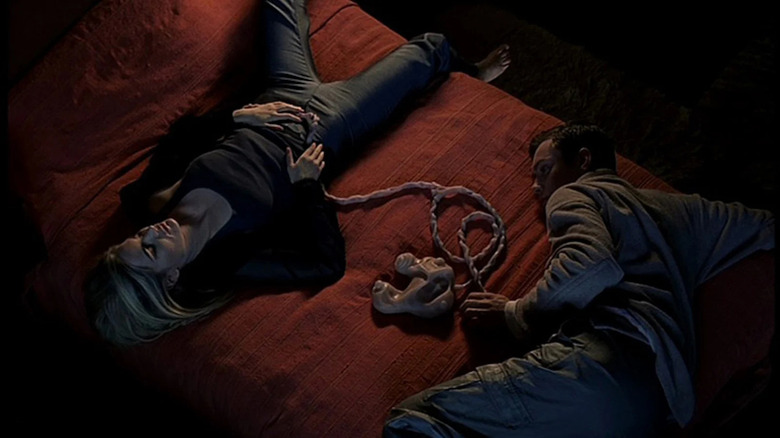Roger Ebert Once Compared This Gritty '90s Sci-Fi Horror Movie To The Matrix
David Cronenberg's 1999 film "eXistenZ" was released only a month after Wachowski Starship's groundbreaking blockbuster "The Matrix," so those who saw it immediately noticed the thematic similarities. Both films are about elaborate simulated video game-like environments, each overseen by a shadowy cabal of mysterious conspirators. In "The Matrix," it was revealed that what we perceive as the real world was actually an elaborate electronic simulation, pumped directly into our brains by a global machine network. The machines used entombed, barely-alive human bodies as a power source, you see, requiring a Matrix to keep our minds occupied. The main characters of the film had found a way to escape the simulation and fight the machines in the real world, a distant future wherein Earth had become a machine-pocked wasteland.
"eXistenZ" didn't have quite so lofty ambitions, but it was just as intense. It took place in the near future, and followed a video game developer named Allegra Gellar (Jennifer Jason Leigh) who has invented the title video game, a simulation module that plugs directly into the human spine. In Cronenberg's version of the future, there aren't a lot of gleaming machines or shiny, light-up displays, but instead organic, semi-living brain pods that plug directly into the body with umbilical cords. Players need to be outfitted with anus-like spinal apertures to play. Simulations look just like the real world, except people's accents are a little ... off.
It's a great sci-fi film, and some would argue its downbeat tone is superior to the whizbang action of "The Matrix." Roger Ebert gave both films three stars and certainly noticed their similarities. In his review of "eXistenZ," he wrote that "'The Matrix' is mainstream sci-fi, but 'eXistenZ,' written by Cronenberg, is much stranger." For me, that usually means better.
eXistenZ is the organic version of The Matrix
Cronenberg has made several sci-fi movies, but he's always focused more on the effects technology has on our extant human bodies than the machines themselves. In his 1983 film "Videodrome," Cronenberg designed VR helmets that look like cocoons or egg sacs. Televisions and videocassettes pulsated and breathed as if they had veins and lungs. Then, in his 1986 film "The Fly," he focused more on his protagonist's bodily transformation into a monstrous insect than on the mechanics of the teleportation pods that caused the transformation. In "eXistenZ," Cronenberg envisioned video games as organic, living things. Game consoles looked like malformed fetuses with weird, nipple-like knobs that had to be manipulated to operate.
Players would plug the umbilical cords into their back-ports and then pass out on the bed, their bodies unconscious as they dream the V.R. game inside the console. Other tech was also organic in "eXistenZ." Cell phones were small, glowing flesh cubes. Guns were made of bones and teeth. In the near future of "eXistenZ," there has been some sort of environmental crisis that mutated some of the local fauna, leading to several scenes starring small, two-headed frog-like creatures. The bone guns are made from their skeletons. Human teeth are the bullets.
The story of "eXistenZ" is a little hard to follow. It seems there is a terrorist organization of anti-video-game crusaders who are attempting to assassinate Allegra Gellar, as her video games pose a threat to sanity; they fear that humans will lose their ability to distinguish between real life and a life online. Hm. I wonder where Cronenberg got that idea. After she survives an assassination attempt, Allegra goes on the lam with an assistant, Ted (Jude Law).
Death the the demons
Ted has never played a video game before and tends to dismiss them. Allegra is convinced that her game is damaged, and needs Ted to get an "umby-port" installed in his spine so they can play the game and see if it needs repairs. There is an amusing scene wherein Willem Dafoe, playing a character named Gas, gets to give Ted a back-alley port installation using something that looks like a motorcycle engine. The game, audiences find, is almost identical to the real world. NPCs get stuck in dialogue loops, and everyone speaks in a stilted fashion, but the details and physics are the same as in the real world. Also, players occasionally have actions forced into their bodies, a means of keeping the "story" moving.
"eXistenZ," likely because it was directly in the shadow of "The Matrix," didn't do well at the box office, only earning $5.5 million on its $15 million budget. Critics generally liked it, however, and Ebert enjoyed the stripped-down aesthetic and the eerie use of video game language. He predicted that gamers would be drawn to "eXistenZ." It's clear that Cronenberg isn't likely to be a gamer himself, but he knows more of the lingo than "The Matrix." Indeed, one might even see "eXistenZ" as a parody of the slick, violent world of "The Matrix." In the Wachowskis' film, VR, while staged as a prison, was also a world of infinite reprogrammable possibilities. In "eXistenZ," VR is a scary, ineffable place where sanity goes to die. And we welcome it with open arms.
Cronenberg's movies tend to swirl into chaos by the end, and the famed Canadian filmmaker is fond of conspiracy stories that deliberately don't have full explanations. They're like nightmares, with sus MIBs around every corner. "eXistenZ" is underappreciated.


